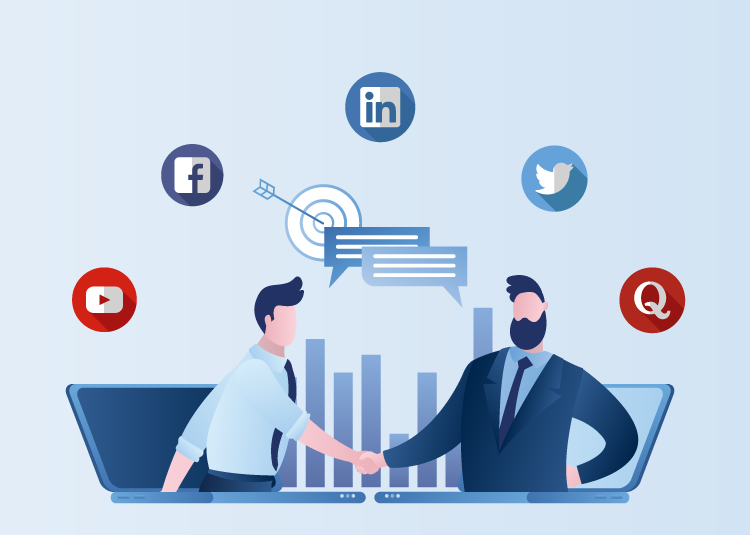
A Comprehensive Guide to B2B2C Marketing
Author: Aaron Smith
It is common knowledge that most companies either sell to other business enterprises (B2B) or to end consumers (B2C). What is not as commonly known is that there exists a third model called B2B2C or Business to Business to Consumer.
A B2B2C company sells to other businesses, let us call them “customer”. However, these “customers” are not the end “consumer” of the products or services. While both entities buy from the business, the “consumer” needs the “customer’s” help to make the final purchase choice.
Examples of B2B2C Companies
Let us try to bring more clarity to the B2B2C phenomenon with examples from two industries, namely the food and beverage industry and the consumer goods industry.
Food and beverage companies are a prime example of the B2B2C type of marketing. When a consumer buys a burger, the soft drink is provided as an add-on, and at a discounted price. The consumers at the time of purchase have a choice of which soft drink to buy from the fountain. More importantly, their soft drink choices get influenced, as the restaurant chooses to carry only certain beverage vendors. To make sure certain beverages are offered up and purchased consistently, the soft-drink providers have to consistently and innovatively market to both businesses as well as consumers.
Consumer goods are another excellent example of a B2B2C model of marketing. Let us look at the case of a detergent company. Consumers purchasing a brand of detergent mostly buy from the same store or supermarket for years. So, how do competitor brands ensure their products get bought? Firstly, other detergent brands must convince their end consumers on the efficacy of their product. Secondly, they must also convince other businesses, e.g. supermarkets, stand-alone stores, etc. to provide them with premium shelf space.
Difference Between B2C and B2B2C
The critical difference between B2C and B2B2C marketing is that in B2B2C, the “customer” plays a significant role in the “consumer’s” purchase choice. In contrast, in B2C, the business sells directly to the “consumer”, and there is no role of the “customer” involved. In the B2B2C model, the delivery channel is separate from the decision channel.
Additional Read: Why Integration of ERP and CRM Systems into Sales and Marketing is Important?
Difference Between B2B and B2B2C
In the B2B marketing model, a business sells directly to another company that is most likely the “consumer”. For instance, the business consumer may purchase CRM software for their enterprise rather than reselling it to another individual consumer. In a B2B2C model, other businesses may be buying the product or service, building upon it, and recommending it to a different end consumer. This recommendation channel then becomes a critical assessment factor for the original seller, to assess the impact of marketing efforts undertaken by them while selling to the business “customer” as well as the “consumer”.
Benefits of B2B2C Marketing
B2B2C lets manufacturers directly market to individual consumers through business customers. This helps reduce the costs involved in supply chain management, which allows brands to lower prices, thus benefitting all three entities. But this is not all? By marketing directly to consumers, businesses gain more control over how they present their brand to the target audience to increase engagement. The time has come to switch from B2B to B2B2C type marketing for several brands. The best way to do it is by harnessing the power of digital marketing and e-commerce.
Tips to Build a Solid B2B2C Marketing Strategy

For end consumers, to be able to interact with brands rather than resellers is a more natural and effective marketing strategy. For example, even though Apple sells its products through authorized multi-brand resellers, consumers purchase these products because Apple talks to them directly. They have developed a niche brand value that resonates with the end consumer. So much so that no multi-brand electronics outlet wants to miss out on displaying Apple products on their shelves. Let us look at the top tips that can help you create a sound B2B2C marketing strategy.
Additional Read: B2B Lead Generation Strategies For Financial Companies: What You Need To Know
-
Serve Distinct Personas
For B2B2C companies, one size fits all approach does not work, since such companies sell to other businesses who are disparate from end consumers. B2B2C enterprises should organize in a way that allows them to serve the distinct needs of each part of their business. A B2B2C brand can do this by splitting their team to gain expertise on the different “customer” as well as “consumer” personas. For example, Groupon has to market to both merchants and consumers. Their relationship with each party has to be customized. Therefore, dedicated teams catering to merchants and consumers are required to enhance their overall experience of interacting with Groupon. Technically, the consumers, as well as merchants, are all customers to Groupon and addressing this spectrum of personas will provide all customers with cohesive product experience.
-
Shift Staff Based on Greatest Needs
Not all business areas demand equal investments at the same point in time. Often B2B2C companies may begin by building out their business side first to create a compelling product or service offering. However, once the business or vendor side is up and running and starts gaining traction, the priorities of B2B2C companies may shift to building a connection with the end consumer. Both the vendor side, as well as the customer side, is critical for your business’s success. However, this does not mean that a company must allocate an equal amount of staff and resources to address both. Contemplate where a development squad or special team can make the most significant impact and increase the staff headcount accordingly.
-
Address End User Directly or Indirectly
After smart staffing, identify and provide either direct or indirect attention to the problems constraining your growth. For instance, if your “consumer” demand is not growing as steadily as you had projected, address the “consumers” directly by introducing stickier strategies for acquisition as well as retention. Alternatively, you can also indirectly increase demand by improving or changing the supplier quality.
-
Use Data Metrics for Alterations
Use data to strike the correct balance. The impact of data powered metrics has a far-reaching effect on providing businesses with accurate feedback. E.g. Metrics that answer questions like, “are “customers” and “consumers” achieving their desired outcome can prove to be useful. Use the results from such metrics to decide on a mix of professionals with specific skill sets who can build better marketing strategies.
-
Provide Consistent Omnichannel Brand Experience
In today’s era of digital marketing, B2B2C brands must focus on providing their target market with an exceptional and consistent brand experience both to their “consumers” and business “customers”. Leverage multiple digital channels like social media, blog sites, online broadcast channels, e-retail portals to give your end-users a customized message and experience to increase engagement.
On the one hand, your business must have a structured sales force performing solid account management for other companies that act as intermediaries to your end consumers. On the other hand, you must dedicate resources for branding and marketing your product or service to keep your end consumer engaged. If you get your end-users love your business offerings, they will enhance your B2B sales as well.




